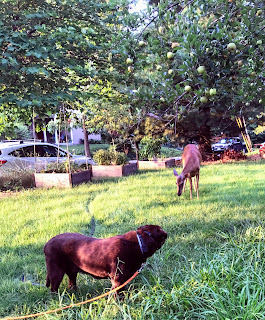Because I can, I've accessed very local rainfall records and drawn a picture. One of my neighbors, about a quarter-mile away, participates in the Community Collaborative Rain, Hail, and Snow network. Every day, since the middle of 2006, she posts the previous day's precipitation totals into a website created for the purpose. There are thousands of people doing this around the country, and it provides a database for researchers looking for hyper-local effects, on daily weather and on climate. There are about 20 reporting stations in our very large county. Having this fairly granular data is especially helpful in thunderstorm country where idiosyncratic effects lead to big differences. (For example, a couple of years ago, National Airport a mere 12 miles away, received six inches of rain IN AN HOUR, but we got about two. We got a lot of rain, but not the record.
The main thing I use this data for is deciding when to water my own garden. But, looking at the graph of cumulative rainfall for every year since 2007 leads to some interesting musings about patterns of rainfall here.
For starters, most rainfall totals cluster around the average. But we've had two years that very much stand out from the pack: 2007 was by far the driest year since 2006 (and would have been even drier had it not been for an October storm dumping a few inches at once). On the high end, 2019 takes the cake by a lot. It doesn't really stick out in my mind as being that rainy, but I guess it was.
More interestingly, when a year diverges from the average makes a difference. Our record dry year, 2007, was average through the beginning of May. Our wet year, 2018, was only slightly above average in mid-July. And then it took off! Last year, 2019, was average until early July, and then the rain turned off for nearly three months. But we finished the year well within the average band we see in the greyed out history.
This year (bright red) has had above average precipitation right out of the starting gate. Even our spring was wetter than average. My observation has been that for my garden, full of spring wildflowers
and shady natives, the early rain is important for the whole year. So
that's good news. But lately, the rain has come in some big huge dumps, resulting in the stair-step look of the line. We got 1.75" in rain in two hours one night! One issue of these huge dumps is that much of the water isn't absorbed locally, because it comes down too fast. It just runs off, frequently taking some of the soil with it.
We do things to capture and retain both the water and the soil, to some effect. The single biggest thing is to avoid having any bare dirt. Plant, plant, plant, especially on slopes. Mulch in the places the plants haven't filled yet. I have some steep slopes at the edges of my yard, because my house sits on a relatively level plot created by scooping the top end and building up the bottom portion, and the street was left at almost natural steep grade.
 |
| This view of the steps to my front door also shows the steep slope of the street. |
My whole neighborhood, built on steep slopes above a creek, has rain gardens to retain even more water, built by the county to try to improve Chesapeake Bay water quality. They dug out more than eight feet down, filled the bottom six feet with what looked like plastic giant egg crates, then put rocks, gravel, soil on top, leaving the spot below grade and with drain pipes leading in from uphill and out from downhill. The soil is planted with an attractive variety of native plants that are well equipped to handle flood/drought stages repeatedly. After a big rainfall, the below-ground areas store water, which then slowly leaches out through the soil, leaving behind various contaminants. Each site requires significant maintenance of the plantings - weeds are ready and able to move in and take over.
The big climate question is volatility. Will we continue to see these huge, record-setting storms?













